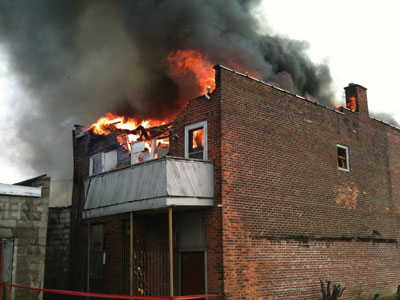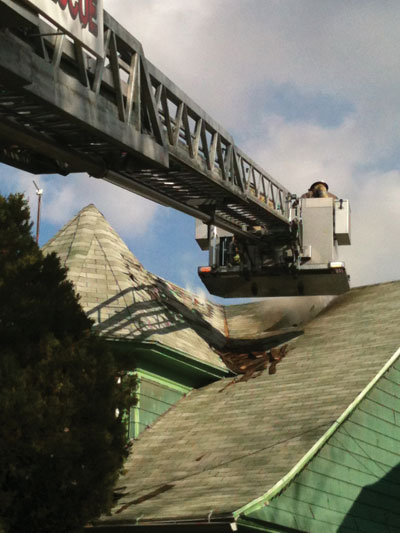
Features
Structural
Training
Fire attack – part 2
In continuing the discussion on fire attack that we started in the January issue
April 4, 2012
By Robert Krause
In continuing the discussion on fire attack that we started in the January issue (go to www.firefightingincanada.com and click on past issues), I want to pay particular attention to residential structure fires, which include single-family homes and multi-unit apartments.
 |
|
| The use of the geographic terms can help to determine the location of a missing or downed firefighter. A firefighter who calls a mayday and reports that he is trapped on division 2 in quadrant 3 pinpoints the location for RIT members and localizes search efforts (compared to saying, “Mayday, mayday, I’m trapped on the second floor.”). Photo by Robert Krause
|
Fires in residential structures present significant hazards to the occupants and to firefighters. The available staffing has an impact on which actions firefighters can undertake simultaneously.
As I mentioned in January, three firefighters arriving on the initial engine company seems to be the norm for many Canadian departments. While some departments may have higher staffing levels, for our discussion, we will presume three firefighters arriving on the initial engine company or pumper crew.
Residential structure fires present a significant life hazard to the occupants. It should be the goal of every fire department and its firefighters to aggressively promote the use and proper installation of smoke alarms in every home, apartment and building in their communities in which there is potential for loss of life.
Working fires within a single-family home or a multi-unit apartment present many challenges for responding firefighters. The incident commander arriving at this type of fire must quickly size up the fire conditions, the risk to any occupants, and the risks to firefighters, and develop a strategy to quickly and safely extinguish the fire while minimizing the dangers.
It is important to review some geographical areas on the fire ground, and assign proper terminology to each area. The front of a building is called side alpha, the left side of the building is called bravo, the rear of the structure is called charlie and the right side of the building delta.
Floors within a structure are called divisions. Here’s an example to illustrate the use of these geographic terms. “Dispatch, this is engine 16. We have a two-storey wood-frame structure with heavy fire on division 2, venting out the windows on sides bravo and charlie.” Using these geographic terms should give the other responding fire companies a good indication of what the fire looks like and where the fire is located.
The floors, or divisions, within the building are broken into quadrants. Quadrant 1 is the front left corner, quadrant 2 is the rear left corner, quadrant 3 is the right rear corner and quadrant 4 the front right corner. I strongly recommend the adoption and use of these terms to simplify fire-ground operations, create common terminology and help to pinpoint geographic areas on the fire ground.
It is important to remember that the front of the building is given the alpha designation (see photo 1). The use of the geographic terms can also help to determine the location of a missing or downed firefighter. A firefighter who calls a mayday and reports that he is trapped on division 2 in quadrant 3 pinpoints the location for RIT members and localizes search efforts (compared to saying, “Mayday, mayday, I’m trapped on the second floor.”).
Here’s a fire scenario. It is 2 a.m., your fire company has been dispatched to a reported structure fire. The location of the fire is 6.5 kilometres from the fire station. When you arrive on scene you observe the following: a two-storey, wood-frame, single-family dwelling with heavy, fast-moving smoke conditions coming from the upstairs windows on side alpha. There is no visible fire from the front of the house. As you dismount the apparatus, family members approach you, screaming that their teenage son is unaccounted for and may still be in the house. You have three firefighters on the first-arriving engine; the second due engine with four additional firefighters will arrive in two minutes. The nearest truck company with four firefighters will arrive in five minutes. What are you going to do to fight this fire?
The incident commander must quickly size up the fire problem, identify the risks to potential occupants and make strategic decisions. There are two high-priority tasks that must be addressed. The first is locating the potentially trapped victim, and the second is suppressing the fire. The first order from the incident commander should be to stretch a hand line up to division 2 and attempt to locate and extinguish the main body of the fire. This scenario calls for an aggressive fire attack to be mounted by the first-arriving fire company. Allowing the fire to go unchecked in lieu of a search effort for the potential victim greatly intensifies the threat to both the firefighters and the trapped victim. If no immediate attempt is made to extinguish this fire, it will continue to grow, producing more smoke, high heat conditions and toxic gases.
A word of caution: do not begin breaking windows around the structure in an attempt to ventilate the smoke from the building. This indiscriminate breaking of windows can cause the fire to quickly intensify, allowing for rapid fire spread throughout the entire structure, trapping the firefighters and greatly reducing the chance of survival for the trapped victim.
 |
|
| If fire-ground conditions allow for crews to operate on the roof, putting a hole in the roof will greatly improve conditions within the fire building. Photo by Robert Krause |
The order has been given to stretch a hand line to division 2 and begin attack on the main body of fire. As the second-arriving engine reports on location, the incident commander should assign search to two firefighters from that engine. The order should sound something like this: “Command to engine 2: I want two firefighters to begin search on division 2. I want the remaining two firefighters to stretch an additional hand line to division 2 and your assignment is backup.” Remember, the role of backup is to protect the fire crews operating on the fire floor; your focus should be protecting the egress routes out of the structure. Do not become distracted and begin fire attack in another portion of the building; the role of backup is to protect the fire crews operating in the fire area.
If you are fortunate enough to have additional firefighters arriving on scene, the incident commander should assign additional firefighters to the original attack line or stretch a second attack line to aid in extinguishing a large amount of fire, and, if necessary, assign additional firefighters to begin search operations in other areas of the structure.
While waiting for the truck company to arrive, the incident commander should be determining if vertical or horizontal ventilation will be necessary: the decision to send the truck company to the roof to provide a hole for vertical ventilation should be based on a sound tactical approach. Crews should not be assigned to roof operations if fire has been burning within the attic for several minutes. However, if fire-ground conditions allow for crews to operate on the roof, putting a hole in the roof will greatly improve conditions within the fire building (see photo 2). The products of combustion (which include heat, smoke and toxic gases), will be readily vented out the vertical hole, visibility will improve for interior fire crews, and heat conditions will diminish, which will help firefighters locate the fire and help search crews in their efforts to locate the victim. A reminder for firefighters sent to the roof: if you are given the order to put a hole in the roof for ventilation, remember the proper size for a roof ventilation hole is 4×4 feet.
I strongly recommend the use of a positive pressure ventilation fan to aid your overall ventilation efforts. When using this fan, it is important to remember not to indiscriminately knock out windows within the structure. The concept of effectively using positive pressure relies on having a structure with an opening large enough to allow for products of combustion to be ventilated from the building, while keeping the structure tight. The idea is to pressurize the building, and using the fan to move thousands of cubic feet of air into the building per minute. Breaking windows unnecessarily prevents the fan from pressurizing the building, thereby reducing the amount of smoke and heat cleared from the building. If breaking the window is not necessary to immediately save a life, don’t break it.
Firefighters need to keep in mind that fire can travel very quickly throughout a structure through the natural voids found within the building. Pipe chases, cutouts within walls for electrical and cable lines, and holes in beams and rafters for plumbing are all means of travel from one area of the structure to another.
While completing overhaul operations, it is important to search for fire extension above and below the original fire. You must also look for lateral fire spread that can occur in attic spaces, cocklofts and above drop ceilings.
In buildings with multiple floors, such as apartment buildings, incident commanders should assign search operations in the following manner. In co-ordination with an aggressive fire attack, search operations should be prioritized as follows:
- The fire floor itself
- The floor directly above the fire
- Additional floors above the fire floor
- Remaining floors below the fire floor.
Multi-storey and multi-unit apartment buildings require a considerable number of firefighters to accomplish all the necessary tasks. I urge you to consider calling for additional resources early on in these types of fires so that as fire-ground operations progress, additional resources will arrive in a timely manner to allow you to address all of the complex issues you’re facing.
Next time, I will discuss oriented search and removing victims from fire buildings, and we’ll finish fighting this fire that we started here. I will also discuss the use of 63.5-millimetre (2.5-inch) attack lines.
Get out there and train – your lives and the lives of the people you protect depend on it.
Bob Krause is a battalion chief with the City of Toledo fire department in Ohio and is assigned to Battalion 2. He has 32 years’ experience in emergency services. He holds an International Fire Service Accreditation Congress (IFSAC) certification and several other EMS and fire certifications. Krause has held a variety of positions in the fire service including engine company officer, fire training officer, Fire & EMS Academy program director, fire/EMS communications supervisor and chief of emergency medical services. He is working to complete his doctorate in emergency management. E-mail him at rcktfd@bex.net
Print this page